New York City Drink Ban Won’t Ban Big Gulps
The ban on large-sized sugary drinks proposed last week by New York Mayor Mike Bloomberg, wouldn’t ban the most famous of all the large-sized drinks:
On her way out of a 7-Eleven convenience store in Midtown Manhattan, Cynthia Pendleton-Bailey stopped her husband from grabbing his usual 20-ounce bottle of soda.
“You might as well just get a Big Gulp,” Ms. Bailey said to him, pointing to a row of fountain drink dispensers flanked with cups, all intended to hold nothing less than the largest possible portion of a customer’s (usually sugary) beverage of choice.
“He’s going on an 11-hour trip to North Carolina, so it’ll be easier if he gets it.”
That’s a main selling point for the Big Gulp, the much-loved drink sold at 7-Elevens across the country: bigger is always better. The drink also happens to be an important exception to Mayor Michael R. Bloomberg’s proposed ban on the sale of large sizes of sugary drinks in a variety of places in New York City.
The ban, which the mayor is proposing as a way to combat rising obesity rates, affects sales of large sugary drinks in delis, fast-food restaurants, movie theaters and the like, but exempts the sale of drinks in groceries or convenience stores.
The Big Gulp holds institutional importance to 7-Eleven, not only as a large source of revenue, but as a mainstay on those green-and-orange pit stops that have become a staple of American and international culture. (There are 46,000 7-Eleven stores worldwide, according to the company’s Web site.)
As 7-Eleven says, Gulps (20 ounces) Big Gulps (30 ounces), Super Big Gulps (40 ounces) and Double Gulps (50 ounces) are “genetically engineered to quench even the most diabolical thirst.”
But dieters might want to steer clear. A Double Gulp filled with Coca-Cola, for instance, has about 600 calories — almost 25 percent of the recommended caloric intake for a 30-year-old, 160-pound man who exercises regularly.
The Gulps, which have more or less defined American “supersize me” beverage culture since the 1970s, cost from $1.23 to $1.84.
7-Eleven was one of the first major retailers in the country to offer self-serve drinks, initially offering 12- and 20-ounce options.
The company introduced the line of Big Gulp products in 1976. The Big Gulp nearly doubled the fountain drink profits of 7-Eleven, a privately held company, though it does not release details on the sales of its individual products.
In 1988, the company came out with the 64-ounce Double Gulp, which, in its sugary guise, had more than 750 calories.
(…)
Some of the managers of the 92 7-Eleven franchises in New York City estimated that almost 10 percent of their overall store income comes from the sale of Big Gulps.
Dilip Chaudhari, 37, the manager of a 7-Eleven on 42nd Street near Ninth Avenue in Manhattan, said the shared sentiment among customers was that even if the ban were eventually extended to the Big Gulp — which the mayor’s office has shown little indication of trying to do — people would still drink the same amount. “They’re going to just buy two or three cups instead,” Mr. Chaudhari said. “Who’s going to stop them? If anything, pollution will go up with all the extra cups people might buy.”
Indeed, it most likely will.
Photo via Wikipedia
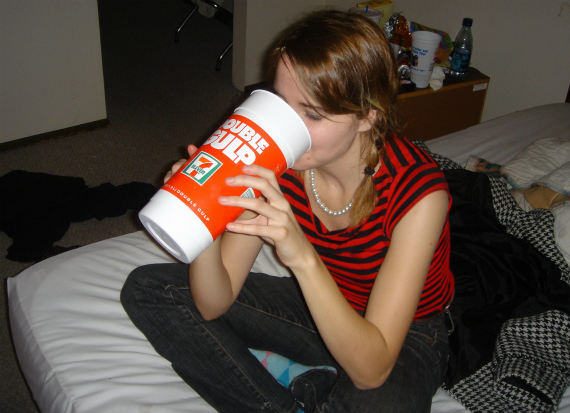

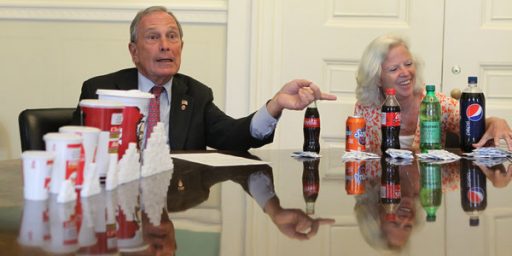
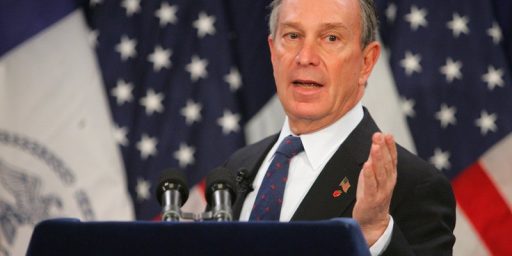
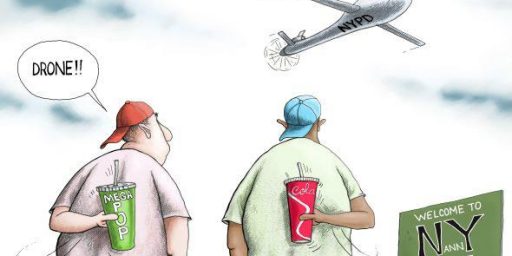
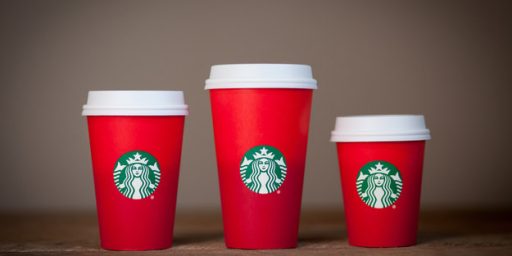
Here’s a thought: why not extend the size ban on beverages to single servings of alcohol, as well? No beers or malt liquors larger than 16 ounces. After all, beer is at least as fattening as soda, isn’t it? And with all the health dangers that come with alcohol?
why not extend the size ban on beverages to single servings of alcohol, as well?
The reason sugary drinks are targeted is they have been identified as a very large contributor to the spike in obesity and diabetes seen over the past three decades, especially among children.
Such a ban wouldn’t do anything to solve the problem, IMO, but that is the reason for it.
Two words, mantis:
“Beer belly.”
After all, alcohol is converted to sugar in the body. And drunk people are even less likely to exercise after consuming than a soda drinker.
Wrong again, Mr. Science.
@Jenos Idanian #13:
You never miss a chance to miss the point, do you Jenos?
I never said alcohol doesn’t contribute to obesity. I said the reason sugary drinks are targeted is because they are seen as the key culprit in the rise of obesity and diabetes in the last 30 years. Alcohol is not. In fact, during that time alcohol consumption has gone down. Do you understand or do I need to use smaller words?
The most entertaining thing about this (as someone who doesn’t live in New York), is that the people who are normally for restricting adults ability to consume what they want (ie the people who are for the war of drugs) are suddenly for freedom to consume, and the people who are normally against restricting freedom to consume are suddenly for it.
Did people mistakenly grab the other side’s playbooks?
OK, I oversimplified — alcoholic beverages tend to contain a lot of sugars, and compounds that break down into sugars. But I think my point should have been clear — who the hell drinks straight alcohol?
And let’s not forget Dave Barry’s long-standing jihad against the unspeakable evil that is Light Beer.
We wouldn’t even have Light Beer if people weren’t seriously concerned about the calories in beer — and other alcoholic beverages.
And besides obesity, drinking causes a whole raft of other serious (and more imminent) health issues. Why shouldn’t it be restricted, too?
Save our fatties! Ban the 40s!
Here is how I use the Big Gulp: I buy one with no ice, take it home, and I have enough drink for the whole family; usually cheaper than buying a bottled drink at the grocery store. I have done that at the fast food places also if it is just my wife and me sharing a drink. In this way, we are not drinking huge amounts of soft drink, but we are saving some money. I’ll bet the mayor never thought that some people are buying the large drinks for this reason. I do that also when we eat at the restaurant.
maybe one day someone can explain why the convenice store owners generally get their way with city councils, legislatures, etc.
walt,
Maybe you can explain why city government should have the right to tell store owners what size drinks they can sell.
@walt moffett:Maybe that is where they hang out after their meetings, eating hot dogs and drinking large soft drinks!
@Doug Mataconis:
A witness told me once after saying he wouldn’t testify, “you got the whole state behind you, all I got is a house full of ammuntion”. In other words, because you don’t have much choice when the law is passed. Jails Should it have been passed, no. Whether its slurppies or pyrodex, its tween me and the seller.
@racehorse: or is because they have video of you and a companion or nine buying that whilst some one is out of town?
Jared Bernstein is a very smart guy. I like his:
The Evolutionary Biology of Obesity
Basically Doug thinks our politics are stronger than our biology. He is wrong.
Re. 16 oz beers, sure, why not. A pint has always been the ideal serving size.
Let me revisse and extend my drivel..
Jail, locust swarms of license and permit inspectors, tax audits, etc await those who flount the law. Should replace the fragment that begins Jail.